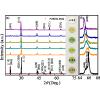当前位置:
X-MOL 学术
›
Phys. Rev. B
›
论文详情
Our official English website, www.x-mol.net, welcomes your feedback! (Note: you will need to create a separate account there.)
Lattice dynamics, phase transition, and tunable fundamental band gap of photovoltaic (K,Ba)(Ni,Nb)O3−δceramics from spectral measurements and first-principles calculations
Physical Review B ( IF 3.7 ) Pub Date : 2018-03-22 00:00:00 , DOI: 10.1103/physrevb.97.094109 Chuanqian Li , Fang Wang , Yuyun Sun , Kai Jiang , Shijing Gong , Zhigao Hu , Zhiyong Zhou , Xianlin Dong , Junhao Chu
Physical Review B ( IF 3.7 ) Pub Date : 2018-03-22 00:00:00 , DOI: 10.1103/physrevb.97.094109 Chuanqian Li , Fang Wang , Yuyun Sun , Kai Jiang , Shijing Gong , Zhigao Hu , Zhiyong Zhou , Xianlin Dong , Junhao Chu

|
Ferroelectrics have long been recognized as one of the candidate class of materials for applications in photovoltaic devices. Recently, ferroelectric perovskite has been successfully synthesized and demonstrated to have a near-optimal band gap (1.39 eV), exhibiting good photovoltaic performance. However, the connection between the structural order-disorder transformation, electronic structure, bulk photovoltaic, and photocatalytic properties remains not well understood. Here, we investigate the phase transition evolutions of lead-free (, ) ceramics via x-ray diffraction (XRD), Raman scattering, and computational evidences. The lattice dynamics and the origin of the successive rhombohedralorthorhombictetragonalcubic phase transitions have been systemically explored based on temperature-dependent XRD peak positions and phonon modes under different geometries. Moreover, the differences in the phase transition temperature and interior structure between the solid solution and the end member highlight local and nonlocal characteristics, which are helpful for understanding the photovoltaic mechanisms. Additionally, the robust photocatalytic decoloration effect on methylene blue can further confirm the photon-generated carrier behavior in the partly structural disordered orthorhombic phase. This identification of structural phases, combined with the ability to perform photocatalytic decoloration, give some insights on promising oxide applications as semiconducting ferroelectric absorbers and carrier-separating layers in photocatalytic or photovoltaic devices.
中文翻译:

从光谱测量和第一性原理计算得出光伏(K,Ba)(Ni,Nb)O3-δ陶瓷的晶格动力学,相变和可调基带隙
长期以来,铁电一直被认为是用于光伏设备的候选材料之一。最近,铁电钙钛矿已经成功地合成了α-己内酰胺并证明其具有接近最佳的带隙(1.39eV),表现出良好的光伏性能。但是,结构的无序转换,电子结构,整体光伏和光催化性能之间的联系仍然不甚了解。在这里,我们研究无铅的相变演变 (, 通过X射线衍射(XRD),拉曼散射和计算证据对陶瓷进行分析。晶格动力学和相继菱面体的起源斜方晶四方的基于温度依赖的XRD峰位置和不同几何结构的声子模式,已经系统地探索了立方相变。此外,固溶体之间的相变温度和内部结构的差异 和最终成员 突出显示局部和非局部特征,这有助于理解光伏机制。此外,对亚甲基蓝的强烈光催化脱色作用可以进一步证实光子产生的载流子在部分结构紊乱的正交晶相中的行为。对结构相的这种识别,加上执行光催化脱色的能力,为有前途的氧化物应用提供了一些见识,这些氧化物在光催化或光伏器件中用作半导电铁电吸收体和载流子分离层。
更新日期:2018-03-22
中文翻译:

从光谱测量和第一性原理计算得出光伏(K,Ba)(Ni,Nb)O3-δ陶瓷的晶格动力学,相变和可调基带隙
长期以来,铁电一直被认为是用于光伏设备的候选材料之一。最近,铁电钙钛矿已经成功地合成了α-己内酰胺并证明其具有接近最佳的带隙(1.39eV),表现出良好的光伏性能。但是,结构的无序转换,电子结构,整体光伏和光催化性能之间的联系仍然不甚了解。在这里,我们研究无铅的相变演变 (, 通过X射线衍射(XRD),拉曼散射和计算证据对陶瓷进行分析。晶格动力学和相继菱面体的起源斜方晶四方的基于温度依赖的XRD峰位置和不同几何结构的声子模式,已经系统地探索了立方相变。此外,固溶体之间的相变温度和内部结构的差异 和最终成员 突出显示局部和非局部特征,这有助于理解光伏机制。此外,对亚甲基蓝的强烈光催化脱色作用可以进一步证实光子产生的载流子在部分结构紊乱的正交晶相中的行为。对结构相的这种识别,加上执行光催化脱色的能力,为有前途的氧化物应用提供了一些见识,这些氧化物在光催化或光伏器件中用作半导电铁电吸收体和载流子分离层。



























 京公网安备 11010802027423号
京公网安备 11010802027423号